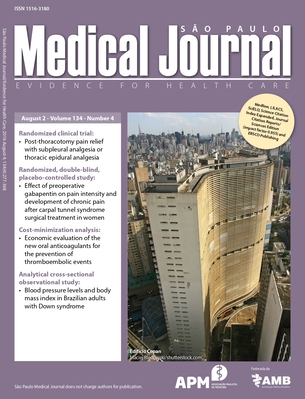Hematological approaches to multiple myeloma
trends from a Brazilian subset of hematologists. A cross-sectional study
Keywords:
Multiple myeloma, Hematology, Physician’s practice patterns, Evidence-based medicine, Evidence-based practiceAbstract
CONTEXT AND OBJECTIVE: For the last nine years, hematologists and oncologists have gathered annually at an educational symposium organized by a Brazilian and an American hospital. During the 2015 Board Review, a survey among the attendees evaluated the differences in management and treatment methods for multiple myeloma (MM). DESIGN AND SETTING: Cross-sectional study during an educational hematology symposium in São Paulo, Brazil. METHODS: Hematologists present at the symposium gave responses to an electronic survey by means of mobile phone. RESULTS: Among the 350 attendees, 217 answered the questionnaire. Most of the participants believed that immunotargeting agents (iTA) might be effective for slowing MM progression in heavily pretreated patients (67%) and that continued exposure to therapy might lead to emergence of resistant clones in patients with MM (76%). Most of the physicians use maintenance therapy after hematopoietic stem cell transplantation (95%) and 45% of them would further restrict it to post-transplantation patients with underlying high-risk disease. The first-line drugs used for transplantation-ineligible patients (TI-MM) were bortezomib-thalidomide-dexamethasone (31%), bortezomib-dexamethasone (28%), lenalidomidedexamethasone (Rd; 17%) and melphalan-based therapy (10%). Lenalidomide was the drug of choice for post-transplantation maintenance for half of the participants. No significant differences were observed regarding age or length of experience. CONCLUSION: The treatment choices for TI-MM patients were highly heterogenous and the melphalanbased regimen represented only 10% of the first-line options. Use of maintenance therapy after transplantation was a common choice. Some results from the survey were divergent from the evidence in the literature.
Downloads
References
Smith A, Howell D, Patmore R, Jack A, Roman E. Incidence of haematological malignancy by sub-type: a report from the Haematological Malignancy Research Network. Br J Cancer. 2011;105(11):1684-92.
Palumbo A, Anderson K. Multiple myeloma. N Engl J Med. 2011;364(11):1046-60.
Becker N. Epidemiology of multiple myeloma. Recent Results Cancer Res. 2011;183:25-35.
Hungria VT, Maiolino A, Martinez G, et al. Confirmation of the utility of the International Staging System and identification of a unique pattern of disease in Brazilian patients with multiple myeloma. Haematologica. 2008;93(5):791-2.
Hungria VTM, Maiolino A, Martinez GA, et al. Multiple myeloma profile in Latin America: clinical and epidemiological observational study. Blood. 2013;122(21):5327. Available from: http://www.bloodjournal.org/content/122/21/5327.article-info?sso-checked=true. Accessed in 2015 (Oct 14).
Minnicelli C, Maciel JF, Hassan R, Lemos TM. Clinical and epidemiological features of multiple myeloma patients from a low socio-economic region of Brazil. Rev Bras Hematol Hemoter. 2015;37(5):354-5.
Ayed AO, Chang LJ, Moreb JS. Immunotherapy for multiple myeloma: Current status and future directions. Crit Rev Oncol Hematol. 2015;S1040-8428(15):00124-9.
Phipps C, Chen Y, Gopalakrishnan S, Tan D. Daratumumab and its potential in the treatment of multiple myeloma: overview of the preclinical and clinical development. Ther Adv Hematol. 2015;6(3):120-7.
Plesner T, Arkenau HT, Lokhorst HM, et al. Safety and efficacy of daratumumab with lenalidomide and dexamethasone in relapsed or relapsed, refractory multiple myeloma. J Clin Oncol. 2014;32(Suppl):5s. [Abstract 8533]. Available from: http:// meetinglibrary.asco.org/content/131350-144. Accessed in 2015 (Oct 14).
Richardson PG, Laubach JP, Munshi NC, Anderson KC. Early or delayed transplantation for multiple myeloma in the era of novel therapy: does one size fit all? Hematology Am Soc Hematol Educ Program. 2014;2014(1):255-61.
San Miguel J. Multiple myeloma: a model for scientific and clinical progress. Hematology Am Soc Hematol Educ Program. 2014;2014(1):1-7.
Morgan GJ, Gregory WM, Davies FE, et al. The role of maintenance thalidomide therapy in multiple myeloma: MRC Myeloma IX results and meta-analysis. Blood. 2012;119(1):7-15.
Moreau P, Attal M, Facon T. Frontline therapy of multiple myeloma. Blood. 2015;125(20):3076-84.
Attal M, Lauwers-Cances V, Marit G, et al. Lenalidomide maintenance after stem-cell transplantation for multiple myeloma. N Engl J Med. 2012;366(19):1782-91.
McCarthy PL, Owzar K, Hofmeister CC, et al. Lenalidomide after stem-cell transplantation for multiple myeloma. N Engl J Med. 2012;366(19):1770-81.
Facon T, Mary JY, Hulin C, et al. Melphalan and prednisone plus thalidomide versus melphalan and prednisone alone or reduced- intensity autologous stem cell transplantation in elderly patients with multiple myeloma (IFM 99-06): a randomised trial. Lancet. 2007;370(9594):1209-18.
Wijermans P, Schaafsma M, Termorshuizen F, et al. Phase III study of the value of thalidomide added to melphalan plus prednisone in elderly patients with newly diagnosed multiple myeloma: the HOVON 49 Study. J Clin Oncol. 2010;28(19):3160-6.
Hulin C, Facon T, Rodon P, et al. Efficacy of melphalan and prednisone plus thalidomide in patients older than 75 years with newly diagnosed multiple myeloma: IFM 01/01 trial. J Clin Oncol. 2009;27(22):3664-70.
Fayers PM, Palumbo A, Hulin C, et al. Thalidomide for previously untreated elderly patients with multiple myeloma: meta-analysis of 1685 individual patient data from 6 randomized clinical trials. Blood. 2011;118(5):1239-47.
San Miguel JF, Schlag R, Khuageva NK, et al. Persistent overall survival benefit and no increased risk of second malignancies with bortezomib-melphalan-prednisone versus melphalan-prednisone in patients with previously untreated multiple myeloma. J Clin Oncol. 2013;31(4):448-55.
Engelhardt M, Terpos E, Kleber M, et al. European Myeloma Network recommendations on the evaluation and treatment of newly diagnosed patients with multiple myeloma. Haematologica. 2014;99(2):232-42.
Niesvizky R, Flinn IW, Rifkin R, et al. Community-Based Phase IIIB Trial of Three UPFRONT Bortezomib-Based Myeloma Regimens. J Clin Oncol. 2015;33(33):3921-9.
Facon T, Dimopoulos MA, Dispenzieri A, et al. Initial phase 3 results of the first (frontline investigation of lenalidomide + dexamethasone versus standard thalidomide) Trial (MM-020/IFM 07 01) in newly diagnosed multiple myeloma (ndmm) patients (PTS) ineligible for stem cell transplantation (SCT). Blood. 2013;122(21):2. [abstract]. Available from: http://www.bloodjournal.org/content/122/21/2.full.pdf. Accessed in 2015 (Oct 14).






